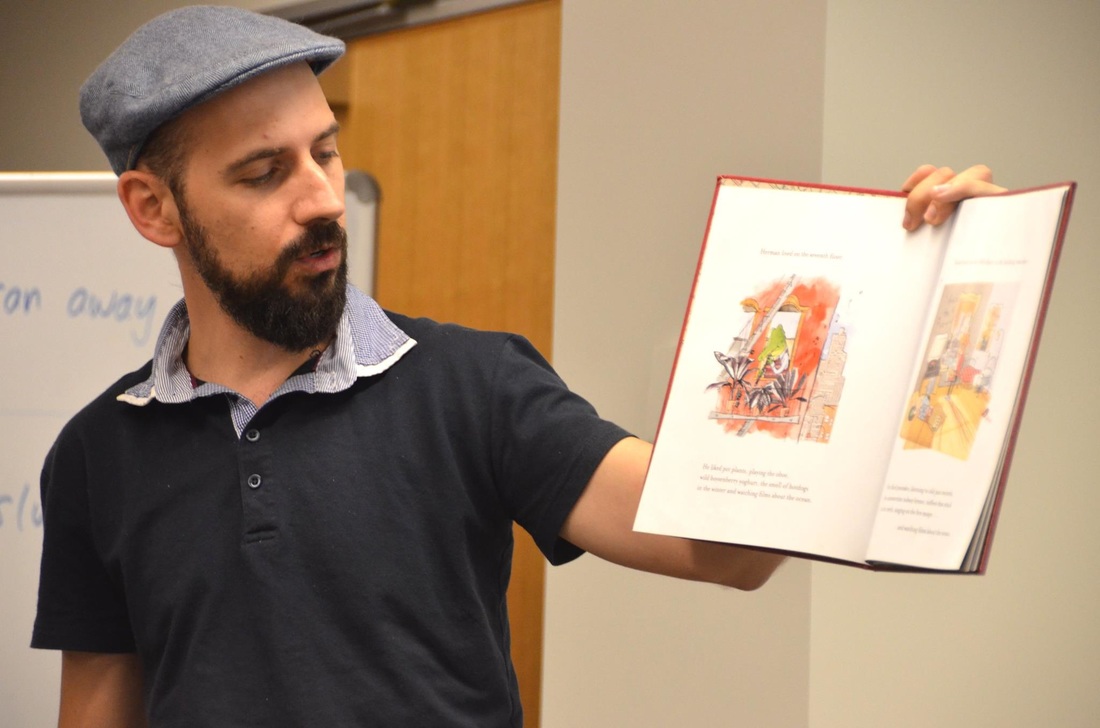Book Links Writers Series – Peter Carnavas on Writing Picture Books
Write Links event on the 5th of March, 2016
Story by Tyrion Perkins Photos by June Perkins
After drawing whales with Peter Carnavas at the Story Arts Literature Festival in Ipswich last year, I was looking forward to his workshop on writing Picture Books. I wasn’t disappointed.
In a sold out session, Peter gave each of us a manila folder of worksheets. He took us through how to get ideas: daydreaming and being open to ideas at all times. He showed examples of picture books starting with characters, e.g. Pig the Pug by Aaron Blabey, and those starting with story, e.g. An Ordinary Day by Libby Gleeson.
He explained how to structure a story and suggested that once you have a beginning and an end, you can work out the middle as you go. He showed in great detail the different types of opening sentences, and as a group we had a go writing each type.
As he explained the elements of Act one, two, and three, he got us to use his worksheet to come up with our own, and share them with the people around us. A new tip I learnt was to include a “blue page” (when all hope is lost before the solution). His worksheet helped me structure my own story about a lizard in my backyard that I had been wanting to write for a while.
Story by Tyrion Perkins Photos by June Perkins
After drawing whales with Peter Carnavas at the Story Arts Literature Festival in Ipswich last year, I was looking forward to his workshop on writing Picture Books. I wasn’t disappointed.
In a sold out session, Peter gave each of us a manila folder of worksheets. He took us through how to get ideas: daydreaming and being open to ideas at all times. He showed examples of picture books starting with characters, e.g. Pig the Pug by Aaron Blabey, and those starting with story, e.g. An Ordinary Day by Libby Gleeson.
He explained how to structure a story and suggested that once you have a beginning and an end, you can work out the middle as you go. He showed in great detail the different types of opening sentences, and as a group we had a go writing each type.
As he explained the elements of Act one, two, and three, he got us to use his worksheet to come up with our own, and share them with the people around us. A new tip I learnt was to include a “blue page” (when all hope is lost before the solution). His worksheet helped me structure my own story about a lizard in my backyard that I had been wanting to write for a while.

He discussed the writing itself, such as:
- Efficiency of words is essential. Leave room for the pictures to tell the story.
- The importance of verbs.
- There is nothing wrong with the word “said” and we discussed how schools are teaching children the opposite.

He took us through story-boarding and tips on how to tell the story visually, and gave us a chart to do our own.
Peter teaches drawing when he visits schools but there was no room in our packed two hours. It concentrated on writing and was perfect for both beginner and experienced, and we all felt the extremely small price of $25 or $15 for Book Links members was well worth it.
If you want to come to the other workshops held at Write Links book at: http://booklinks.org.au/events-2/write-links-writing-workshops/
Peter teaches drawing when he visits schools but there was no room in our packed two hours. It concentrated on writing and was perfect for both beginner and experienced, and we all felt the extremely small price of $25 or $15 for Book Links members was well worth it.
If you want to come to the other workshops held at Write Links book at: http://booklinks.org.au/events-2/write-links-writing-workshops/
Comments
Sorry, the comment form is closed at this time.







Alison
Fantastic article Tyrion! Great photos June! The day was really rewarding–lots of new things to try.